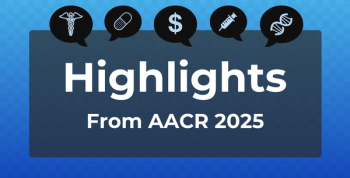
Triple Therapy at 2 Doses Appears to Reduce COPD Exacerbations, Study Says
A trial of 2 doses of an inhaled glucocorticoid in a fixed-dose triple therapy for chronic obstructive pulmonary disease (COPD) appeared beneficial compared with 1 of 2 dual therapies.
A trial of 2 doses of an inhaled glucocorticoid in a fixed-dose triple therapy for chronic obstructive pulmonary disease (
Triple inhaled therapy for COPD consists of a combined inhaled corticosteroid (ICS), a long-acting beta-agonist (LABA), and a long-acting muscarinic antagonist (LAMA). Triple therapy is recommended by the
The trial, called ETHOS (
The metered-dose inhaler, named PT010, was compared with 18 μg of glyopyrrolate plus 9.6 μg of formoterol or 320 μg of budesonide plus 9.6 μg of formoterol. PT010 is sold in Japan and China, but received a Complete Response Letter from the FDA last year, according to AstraZeneca, which sponsored the study.
Over 52 weeks, researchers sought to determine the rate of moderate or severe COPD exacerbations in patients who had at least 1 exacerbation in the previous year. Participants were aged 40 to 80 years; inclusion criteria included being current or former smokers with a history of at least 10 pack-years of cigarette smoking and a forced expiratory volume in 1 second (FEV1) of <65% and a forced vital capacity (FVC) ratio of <0.70..
Of 8509 patients, the annual rates of moderate or severe exacerbations were 1.08 in the budesonide 320-μg group, 1.07 in the budesonide 160-μg group, 1.42 in the glyopyrrolate-formoterol group, and 1.24 in the budesonide-formoterol group.
Using budesonide at 320 μg resulted in lowering exacerbations by 24% compared with glyopyrrolate-formoterol (95% CI, 0.79 -0.83; P <.001) or 13% compared with budesonide-formoterol (95% CI, 0.79-0.95; P <.003).
The rate of reduced exacerbations using budesonide at 160 μg was 25% lower (95% CI, 0.69-0.83; P <.001).
At either dose, the researchers said that the triple therapy of twice-daily budesonide (160/320 μg dose), glycopyrrolate, and formoterol was better at reducing the rate of moderate or severe COPD exacerbations thant glycopyrrolate-formoterol or budesonide-formorterol.
Reference
Rabe KF, Martinez FJ, Ferguson GT, et al. Triple inhaled therapy at two glucocorticoid doses in moderate-to-very-severe COPD (ETHOS). N Engl J Med. Published online June 24, 2020. doi:10.1056/NEJMoa1916046
Newsletter
Stay ahead of policy, cost, and value—subscribe to AJMC for expert insights at the intersection of clinical care and health economics.









































